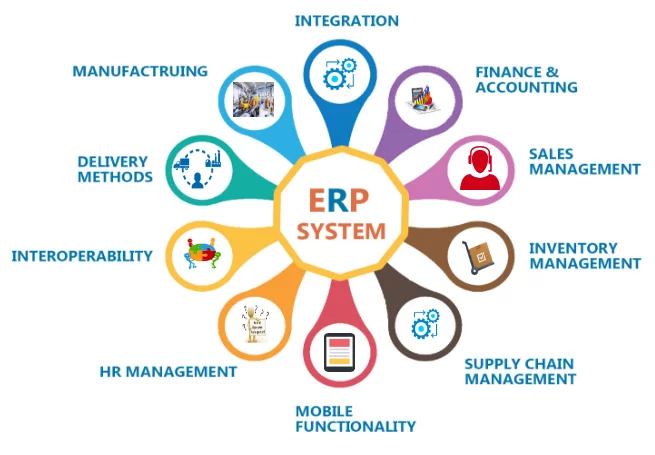In today’s rapidly evolving business landscape, organizations of all sizes are constantly seeking ways to enhance their operational efficiency and streamline their processes. One powerful tool that has emerged to address these needs is Enterprise Resource Planning (ERP) software. But what exactly is ERP software, and how can it benefit your business? This comprehensive overview will help clarify these questions and provide insight into the essential features and advantages of ERP systems.
Understanding ERP Software
ERP software is a type of business management software that integrates and automates core business processes across various departments within an organization. By consolidating data and processes into a single unified system, ERP software enables businesses to operate more efficiently, improve data accuracy, and gain better insights into their operations.
Key Features of ERP Software
- Integration of Core Functions: ERP systems integrate multiple business functions into one platform, including finance, human resources, supply chain management, sales, and customer service. This integration ensures that all departments have access to the same data, reducing duplication and inconsistencies.
- Real-Time Data Access: One of the most significant advantages of ERP software is its ability to provide real-time access to data. This allows businesses to make informed decisions based on the most current information available, improving responsiveness and agility.
- Automated Workflows: ERP software automates routine tasks and workflows, such as order processing, invoicing, and inventory management. Automation reduces manual effort, minimizes errors, and speeds up operations.
- Scalability: ERP systems are designed to grow with your business. They can be scaled to accommodate increasing data volumes and additional users as your organization expands, ensuring that your software continues to meet your needs over time.
- Reporting and Analytics: ERP software offers powerful reporting and analytics tools that enable businesses to analyze their performance, track key metrics, and generate detailed reports. This data-driven approach helps organizations identify trends, forecast future performance, and make strategic decisions.
- Customization and Flexibility: Many ERP systems offer customization options to tailor the software to the specific needs of your business. This flexibility ensures that the ERP system can adapt to your unique processes and requirements.
Benefits of ERP Software
- Improved Efficiency: By automating and integrating business processes, ERP software streamlines operations and reduces the time spent on manual tasks. This leads to increased productivity and operational efficiency.
- Enhanced Data Accuracy: ERP systems provide a single source of truth for your organization’s data. With all information centralized in one system, the risk of errors and discrepancies is significantly reduced.
- Better Decision-Making: Access to real-time data and advanced analytics empowers decision-makers with the insights needed to make informed choices. This can lead to more strategic planning and improved business outcomes.
- Cost Savings: While the initial investment in ERP software can be substantial, the long-term benefits often outweigh the costs. Reduced operational inefficiencies, lower administrative overhead, and improved resource management can lead to significant cost savings.
- Regulatory Compliance: ERP systems often include features that help businesses comply with industry regulations and standards. Automated reporting and audit trails ensure that your organization meets legal and regulatory requirements.
- Enhanced Customer Service: By improving access to customer data and streamlining order fulfillment processes, ERP software can enhance customer service and satisfaction. Faster response times and accurate order processing contribute to a better overall customer experience.
Implementing ERP Software
Implementing ERP software is a significant undertaking that requires careful planning and execution. Key steps in the process include:
- Needs Assessment: Assess your organization’s needs and identify the specific features and functionalities required from an ERP system.
- Vendor Selection: Research and select an ERP vendor that offers a solution that aligns with your needs and budget. Consider factors such as system capabilities, scalability, and vendor support.
- Customization and Configuration: Work with the vendor to customize and configure the ERP system to meet your organization’s requirements. This may involve setting up modules, workflows, and user roles.
- Training and Support: Provide training to your staff to ensure they are proficient in using the ERP system. Ongoing support and maintenance are also crucial to address any issues that arise and keep the system running smoothly.
- Data Migration: Transfer data from existing systems to the new ERP system. Ensure that data is accurately migrated and validated to avoid disruptions.
- Go-Live and Evaluation: Launch the ERP system and monitor its performance. Evaluate the system’s effectiveness and make adjustments as needed to optimize its functionality.
Conclusion
ERP software is a powerful tool that can transform the way your organization operates. By integrating core business processes, automating workflows, and providing real-time insights, ERP systems enable businesses to achieve greater efficiency, accuracy, and strategic decision-making. As you consider implementing an ERP solution, carefully evaluate your needs and choose a system that aligns with your goals to maximize the benefits and drive long-term success.
